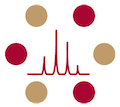2018 SUMS-RAS Sponsor Seminar Abstracts

Thursday, October 4th, 2018
Frances C. Arrillaga Alumni Center
Fisher Conference Center
SPONSOR SEMINARS
|
Semi-Automated Sample Prep for Quantitative Phosphoproteomics using the AssayMAP Platform
Randy Bolger, PhD, Manager - Workflow Solutions, Americas, Agilent Technologies, Inc.
Reversible protein phosphorylation is the primary regulator of intracellular signaling. The low abundance of cellular protein phosphorylation requires targeted enrichment prior to sensitive LC/MS analysis. Today, phosphopeptide enrichment is typically reliant on labor-intensive sample preparation methods resulting in workflows lacking robustness and scale. |
|
Proteomic Applications of Sensitivity ad Speed with the timsTOF Pro and PASEF
Chris Adams, PhD, West Coast Proteomics Manager, Bruker Daltonics
|
|
New Software for Structural Biology by Mass Spectrometry
Marshall Bern, PhD, Vice President, Protein Metrics
The three major technologies (x-ray crystallography, NMR, and cryo-EM) for determining 3D structures of biomolecules require special-purpose instrumentation, pure and homogeneous samples, and specialized expertise. Mass spectrometry offers several ways to probe structure that overcome these limitations and complement the structure-determination methods: covalent labeling, hydroxyl-radical footprinting, hydrogen-deuterium exchange, and cross-link analysis. The talk will show examples of each of these methods, and describe work in progress on an integrated software platform for analyzing the data from these experiments.
|
|
New Trends and Solutions in –Omics
Suraj Dhungana, PhD, Biomedical Research Market Development Manager, Waters Corporation
Quantitative temporal information on metabolites and proteins along with a good knowledge of their spatial distribution are key to understanding biochemical processes. A strong drive to translate discovery omics results to clinical practice has necessitated the acquisition of quantitative temporal and spatial information in a clinically relevant high throughput manner. To address some these new trends in omics research, number of new solutions have been developed. The presentation will cover the latest development in clinically relevant high throughput proteomics, plug and play MetaboQuan® targeted metabolomics methods, metabolic flux workflow, and comprehensive mass spectrometry imaging solutions for molecular visualization.
|

